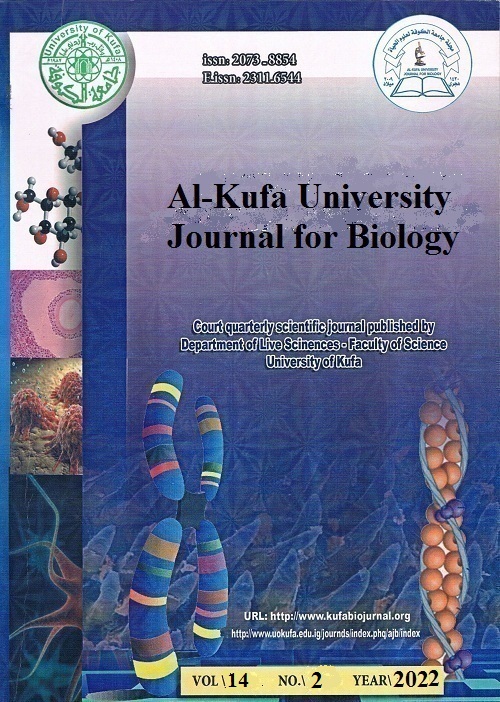The relationship between type 2 diabetes mellitus and Hba1c and some immunological parameters
DOI:
https://doi.org/10.36320/ajb/v14.i2.10381Keywords:
type 2 diabetes, CRP II, Hba1c, IL-6Abstract
This study knew that comparing type 2 diabetes mellitus and some pro-inflammatory immune factors, IL-6 and CRP clarified the higher glucose and their relationship in stimulating these immune factors. Type II diabetes mellitus, elevated incidence of disease, elevated IL6 and CRP II, in the absence of substrates run on elevated blood glucose.
Downloads
References
American Diabetic Association (2010).Executive Summary: Standards of Medical Care in Diabetes—2010: Current criteria for the diagnosis of diabetes. Diabetes Care 33: S4-S10.
Centers for Disease Control and Prevention. National DiabetesStatistics Report (2017). Atlanta, GA: Centers for Disease Control and Prevention, U.S. Dept of Health and Human Services .2017.
Cinek O, Kramna L, Mazankova K, Odeh R, Alassaf A, Ibekwe MU, Ahmadov G, Elmahi BME, Mekki H, Lebl J, Abdullah MA. The bacteriome at the onset of type 1 diabetes(2018). A study from four geographically distant African and Asian countries. Diabetes Res Clin Pract; 144: 51-62. DOI: https://doi.org/10.1016/j.diabres.2018.08.010
Recasens M, Lopez-Bermejo A, Ricart W, et al. An inflammation score is better associated with basal than stimulated surrogate insulin resistance indexes. Clin Endocrinol Metab 2005; 90: 112–116. DOI: https://doi.org/10.1210/jc.2004-0708
Kolb H, Mandrup-Poulsen T. (2010)The global diabetes epidemic as a consequence of lifestyle-induced low-grade inflammation. Diabetologia ; 53: 10–20. DOI: https://doi.org/10.1007/s00125-009-1573-7
Howren MB, Lamkin DM, Suls J. (2009). A meta-analysis is associated with depression with C-reactive protein, IL-1, and IL-6. Psychosom Med; 71: 171–186. DOI: https://doi.org/10.1097/PSY.0b013e3181907c1b
Preshaw PM, Alba AL, Herrera D et al. (2012). Periodontitis and diabetes: a two-way relationship. Diabetologia; 55: 21–31. DOI: https://doi.org/10.1007/s00125-011-2342-y
Sattar N, Wannamethee SG, Forouhi NG. (2008).Novel biochemical risk factors for type 2 diabetes: pathogenic insights or prediction possibilities? Diabetologia; 51: 926–940. DOI: https://doi.org/10.1007/s00125-008-0954-7
Ouchi N, Parker JL, Lugus JJ, Walsh K. (2011). Adipokines in inflammation and metabolic disease. Nat Rev Immunol; 11: 85–89. DOI: https://doi.org/10.1038/nri2921
Osborn O, Olefsky JM. (2012). The cellular and signalling networks link the immune system and metabolism in disease. NatMed; 18: 363–374. DOI: https://doi.org/10.1038/nm.2627
Donath MY, Shoelson SE. (2011). Type 2 diabetes is an inflammatory disease. Nat Rev Immunol; 11: 98–107. DOI: https://doi.org/10.1038/nri2925
Freeman DJ, Norrie J, Caslake MJ, et al. (2002). C-reactive protein is an independent predictor of risk for the development of diabetes in the West of Scotland Coronary Prevention Study. Diabetes; 51: 1596- 1600. DOI: https://doi.org/10.2337/diabetes.51.5.1596
Fernandez-Real JM, Broch M, Vendrell J, et al. (2000). Interleukin-6 gene polymorphism and insulin sensitivity. Diabetes; 49: 517-520. DOI: https://doi.org/10.2337/diabetes.49.3.517
Greenfield JR, Campbell LV: (2006). Relationship between inflammation, insulin resistance and type 2 diabetes: ‘cause or effect’? Curr Diabetes Rev, 2:195-211. DOI: https://doi.org/10.2174/157339906776818532
The International Expert Committee. (2009). International Expert Committee report on the role of the A1C assay in diagnosing diabetes. Diabetes Care; 32 (7):1327-1334. DOI: https://doi.org/10.2337/dc09-9033
American Diabetic Association. (2010). Executive Summary: Standards of Medical Care in Diabetes—2010: Current criteria for the diagnosis of diabetes. Diabetes Care; 33: S4-S10. DOI: https://doi.org/10.2337/dc10-S004
Mark Livingston, Paul Masters (2013).Southern Derbyshire Shared Care Pathology Guideline: SDSCP-5 Version 1 Diagnosis of Diabetes Mellitus using HbA1c. Active Date 14.10.2011 Review Date October.
U.S. DEPARTMENT OF HEALTH AND HUMAN SERVICES National Institutes of Health: The A1C Test and Diabetes. NIH Publication No. 11–7816 September 2011.
Mohd. Idrees Khan, Kauser Usman, Fauzia Ashfaq, D. Himanshu, W. Ali, M.Z. Idris: Association of Hs-CRP and HbA1C with Microalbuminuria in Type-2 Diabetic patients in North India. Biomedical Research 2012; 23 (3): 380-384.
Nikzamir A, Esteghamati A, Feghhi M, Nakhjavani M, Rashidi A, Reza JZ. (2009).The insertion/deletion polymorphism of the angiotensin-converting enzyme gene is associated with albuminuria progression but not development in Iranian patients with type 2 diabetes. J Renin Angiotensin Aldosterone Syst ;10:109-14. DOI: https://doi.org/10.1177/1470320309104872
Azza M. El-Wakf, Tarek M. Abbas, Rizk A. El-Baz, Wafaa A. Mohammed. (2011). Role of hypertension and metabolic abnormalities in diabetic nephropathy among Egyptian patients with type 2 diabetes. Nature and Science; 9(7): 220-228.
Hansen D., P. Dendale, M. Beelen, R. A. Jonkers, A. Mullens, L. Corley et al., (2010). Plasma adipokine and inflammatory marker concentrations are altered in obese, unlike non-obese, type 2 diabetes patients. Eur J Appl Physiol. Jun; 109(3):397-404. DOI: https://doi.org/10.1007/s00421-010-1362-5
Frohlich M., A. Imhof, G. Berg G, (2000). Association between C-reactive protein and features of the metabolic syndrome: a population-based study. Diabetes Care.; 23:1835-1839. DOI: https://doi.org/10.2337/diacare.23.12.1835
Pickup JC, Mattock MB, Chesney GD, Burt D. (1997).NIDDM as a disease of the innate immune system: association of acute-phase reactants and interleukin-6 with metabolic syndrome X. Diabetologia;40:1286–92. DOI: https://doi.org/10.1007/s001250050822
Joachim Spranger, Anja Kroke, Matthias Mohlig, Kurt Hoffmann, Bergmann Manuela M, Michael Ristow, et al. (2003). Inflammatory cytokines and the risk to develop type 2 diabetes. Diabetes;52:812–7. DOI: https://doi.org/10.2337/diabetes.52.3.812
Konukoglu D, Hatemi H, Bayer H, Bagriacik N. (2006).Relation between serum concentrations of interleukin-6 and tumour necrosis factor-a in female Turkish subjects with normal and impaired glucose tolerance. Horm Metab Res;38:34–7. DOI: https://doi.org/10.1055/s-2006-924974
Cardellini M, Andreozzi F, Laratta E, Marini MA, Lauro R, Hribal ML, et al. (2007) .Plasma IL-6 levels are increased in subjects with impaired glucose tolerance but not in those with impaired fasting glucose in a cohort of Italian Caucasians. Diabetes Metab Res;23(2):141–5. DOI: https://doi.org/10.1002/dmrr.679
Downloads
Published
How to Cite
Issue
Section
License
Copyright (c) 2022 Ali A. Mohy, Saleem Khteer Al-Hadraawy, Ahmed yousif jawad

This work is licensed under a Creative Commons Attribution 4.0 International License.
which allows users to copy, create extracts, abstracts, and new works from the Article, alter and revise the Article, and make commercial use of the Article (including reuse and/or resale of the Article by commercial entities), provided the user gives appropriate credit (with a link to the formal publication through the relevant DOI), provides a link to the license, indicates if changes were made and the licensor is not represented as endorsing the use made of the work.












